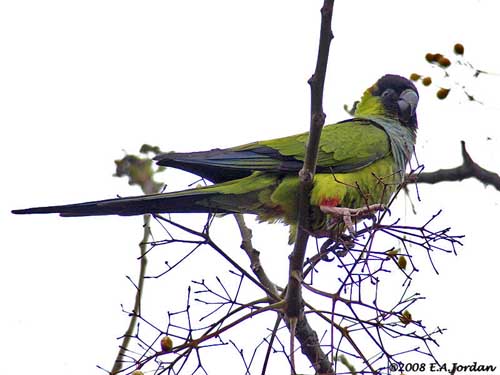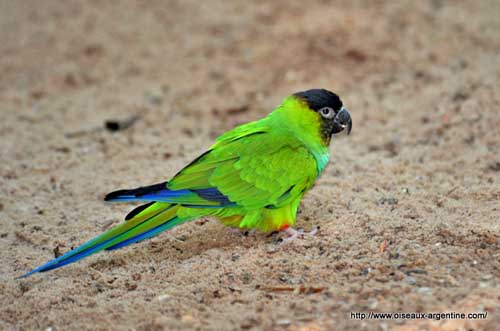
Fr: Conure nanday
All : Nandaysittich
Esp : Aratinga Ñanday
Ital : Conuro Nanday
Nd: Nandayparkiet
Sd: Nandayparakit
Port: Periquito-de-cabeça-preta
Photographers:
Jean Michel Fenerole
Photos d’Oiseaux du monde
Eduardo Andrés Jordan
MIS AVES - AVES DE ARGENTINA
Philippe and Aline Wolfer
OISEAUX D'ARGENTINE
Text by Nicole Bouglouan
Sources:
HANDBOOK OF THE BIRDS OF THE WORLD vol 4 by Josep del Hoyo-Andrew Elliott-Jordi Sargatal - Lynx Edicions - ISBN: 8487334229
PARROTS OF THE WORLD – An Identification Guide – by Joseph M. Forshaw – Princeton University Press – ISBN 0691092516
BirdLife International (BirdLife International)
About.com – Birding / Wild Birds
Nanday Conure
Aratinga (Nandayus) nenday
Psittaciforme Order – Psittacidae Family
BIOMETRICS:
Length: 32-37 cm
Weight: 120-140 g
DESCRIPTION:
This pretty conure is unfortunately a common cagebird. But in spite of regular pet trade, this species is still abundant and common in its range.
The adult has green plumage. On the upperparts, nape, back, rump and upperwing-coverts are green with darker shade. Flight feathers are blue. Rectrices are olive-green with blue tips. Uppertail-coverts are yellowish-green. The long tail is graduated.
The underparts are more yellowish-green on belly and underwing-coverts, whereas throat and upperbreast are strongly washed pale blue. Thighs are deep orange. Vent is slightly darker. Flight feathers and rectrices are dark.
On the head, forehead to nape and face are black. Cheeks are yellowish-green. We can see a bare flesh-coloured eye-ring.
The bill is black. The eyes are dark brown. Legs and feet are pale pinkish.

Both sexes are similar.
The juvenile resembles adults but it has less blue throat and breast, and its tail is shorter.
VOICE: SOUNDS BY XENO-CANTO
The Nanday Conure gives strident, loud “kree-ah… kree-ah… kree-ah” or “krehh” and “kriie-kriie-kriie”. When perched, they utter shrill chatter. Calls are often given to maintain contact between flock’s members.
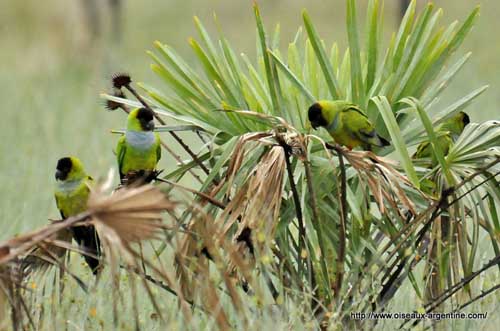
HABITAT:
The Nanday Conure can be seen in open savanna country and pastures, palm groves, low, dry scrublands, gallery forest and remnant deciduous thickets. It also frequents moist Chaco, and can be seen up to 800 metres of elevation or more.
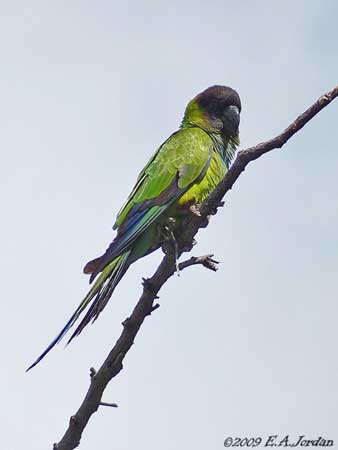
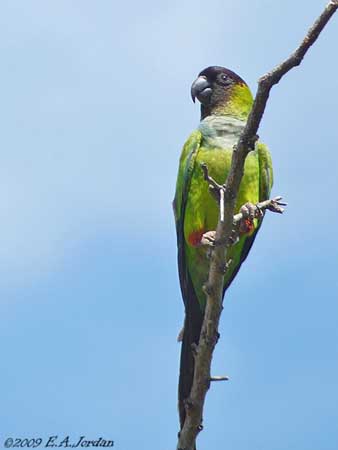
RANGE:
The Nanday Conure occurs in SE Bolivia and SW Brazil, through C Paraguay to N Argentina.
This species is usually common or locally abundant in Pantanal, across the floodplains of the upper Río Paraguay.
There are some feral populations in Buenos Aires, Florida and California, and very small numbers in Puerto Rico.
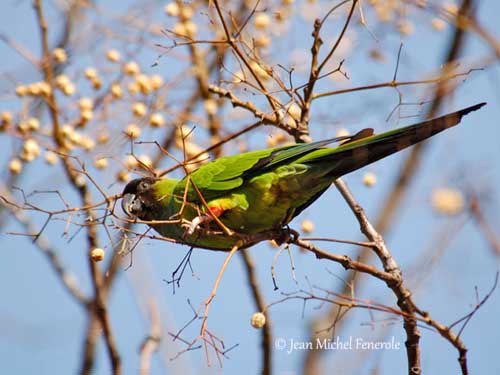
BEHAVIOUR:
The Nanday Conure feeds as well in trees as on the ground. It feeds mainly on palm nuts, seeds, fruits, berries, flowers and buds.
This species benefits from land clearance for agriculture expansion, but it also damages the crops and for this reason, this conure is listed as a pest in some parts of the range.
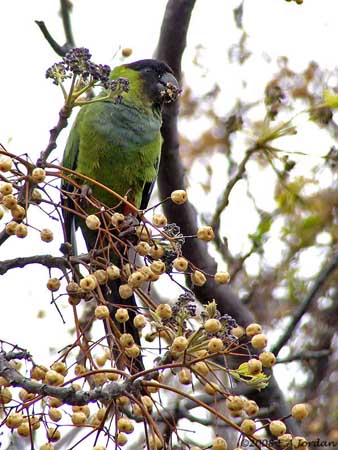
They are gregarious and usually occur in flocks of 10-20 birds. They are noisy and conspicuous. After the nesting period, they spend the night at nightime communal roosts where large numbers sleep together.
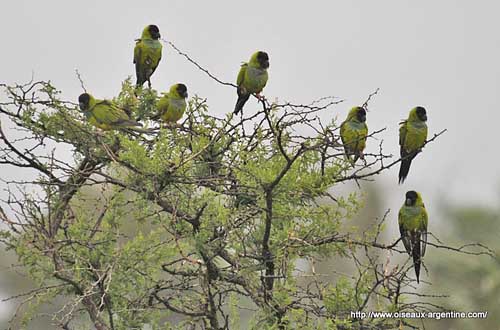
They approach their feeding areas and roost in flock while giving loud calls. The flock is usually heard before to be seen!
During the breeding season, some displays are observed, but mutual preening is the main behaviour for pair-bond maintenance, and courtship feeding often occurs too.
The pair chooses the nest-hole and defends strongly the nest-site once established. Other displays such as head-bobbing, head-stretching and tail-fanning are probably performed.
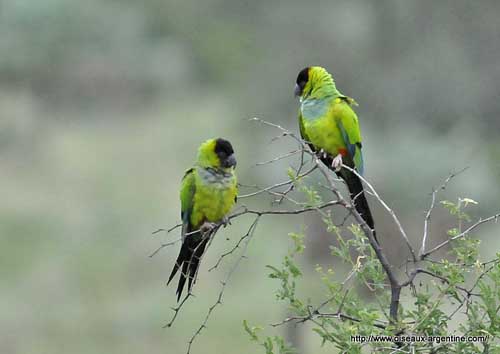
This species is not migratory but flocks may wander in non-breeding season.
FLIGHT:
The Nanday Conure performs swift, direct flight. The wingbeats are steady and rapid, and we can observe the rolling of the body while flying.
REPRODUCTION:
The breeding season occurs in November.
Prospection for nest-hole is often made by several birds, up to 12 together. Holes in trees and fence posts’ tops are interesting nest-sites for this species.
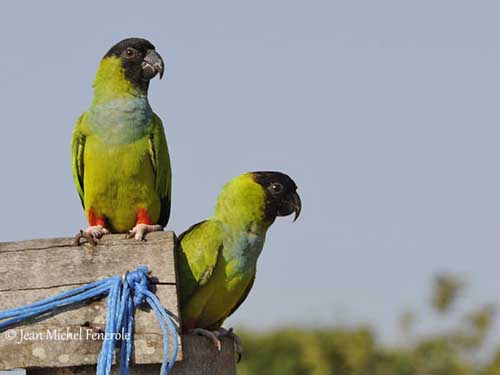
The nest is usually prepared some weeks before the laying. Both sexes may enlarge the entrance or level the floor. Usually, the female takes over the final works.
She lays 3-4 white eggs, and incubates during 21-23 days. During this period, the male often sits near the hole. The chicks fledge 8 weeks after hatching. They can breed at 3 years old.
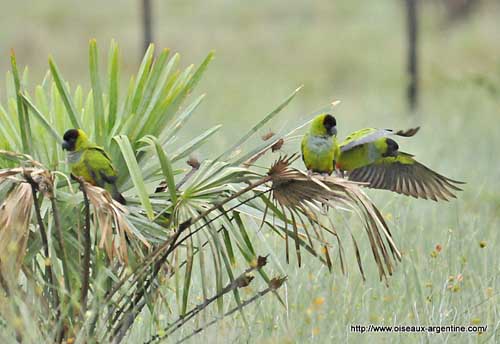
DIET:
The Nanday Conure usually feeds on palm nuts and seeds, fruits and berries, flowers and buds.
They are fairly arboreal, but several food items are taken from the ground.
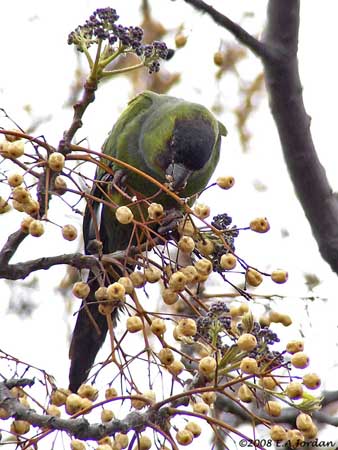
PROTECTION / THERATS / STATUS:
The Nanday Conure is common to locally abundant. It has benefited from land clearance, and its habitat is little modified, or only by grazing.
The species is listed as a pest in Argentina because they damage the crops.
The Nanday Conure is not currently threatened, in spite of trapping for bird trade. This species is a common cage bird.
